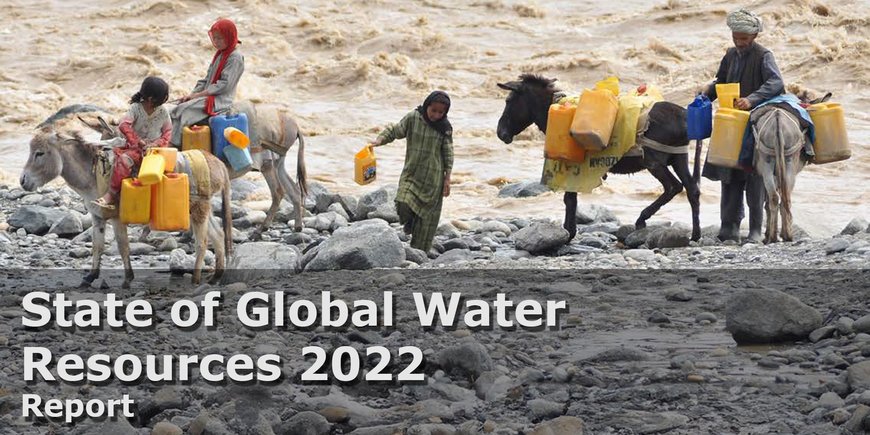The recently published report "State of Global Water Resources 2022" by the World Meteorological Organization WMO offers a comprehensive presentation of the state of water resources in large catchment areas around the world. It contains analyses of the state of large rivers, terrestrial water storage (TWS) and selected parameters of areas characterized by ice (cryosphere). It also includes variables describing groundwater, evapotranspiration, soil moisture and water storage, as well as an overview of the most important hydrological disasters worldwide in 2022.
GFZ research has made a significant contribution to this comprehensive report. Evaluations in the chapter "Terrestrial Water Storage (TWS)" are based on calculations using GRACE and GRACE-FO data in the Global Geomonitoring and Gravity Field (Christoph Dahle) and Earth System Modeling (Henryk Dobslaw, Robert Dill, Eva Börgens) sections. Building on this, Andreas Güntner (Hydrology Section) produced Figures 9 (on the current state of total water storage on continental surfaces worldwide in 2022, classified in relation to the previous years since the start of the mission in 2002) and 10 (on the long-term trend of TWS from 2002 to 2022). Andreas Güntner was also involved in the classification and interpretation of the results. The hydrologist from the GFZ says: "TWS is an important indicator for the state of regional water resources and for the balance of precipitation, evaporation and runoff. TWS was therefore seen by the WMO as an essential component for this report."
Further GFZ research on the water balance in Central Asia was also included in the report. Central Asia not only plays an important role in the world's freshwater resources, but also in supplying water to large parts of the world's population. Data from long-term monitoring programs for the Abramov and Golubin glacier systems, which are provided by CAIAG with the help of Landsat satellite data, were used in the chapter "Snow cover and glaciers" in the main topic "Cryosphere changes and water resources management". CAIAG stands for Central Asian Institute for Applied Geosciences and is a joint initiative of the GFZ and the Republic of Kyrgyzstan. The co-director of CAIAG on the German side, Oliver Bens from GFZ, puts the mapping of the Kyrgyz glaciers into context: "For Kyrgyzstan alone, the nationwide monitoring program has catalogued 9957 glaciers with a total area of 6683.1 square kilometers. In comparison, Germany has 4 glaciers with a total area of approx. 0.12 square kilometers."
The report is available for download at
library.wmo.int/viewer/68473/download
Further information on the GRACE satellite missions and their significance for the recording of the global water cycle can be found on the new information platform globalwaterstorage.info recently compiled by the GFZ.










![[Translate to English:] Torsten Sachs in front of a climate station on a field](/fileadmin/_processed_/3/9/csm__TorstenSachs_bearbeitet_GS_4a1365ef84.jpeg)
![[Translate to English:] left image flood at the Ahrtal: image from above, several houses are flooded; left image:: Heidi Kreibich;](/fileadmin/_processed_/4/4/csm_Bild2_9af0130e9f.png)



![[Translate to English:] Start der Vega Rakete](/fileadmin/_processed_/6/4/csm_20231201-kachel_Vega-VV23-launch_ESA-CNES-Arianespace_706716b68c.jpeg)









![[Translate to English:] Poster exhibition at the Brandenburg Hydrogen Day at the GFZ, some participants in the foreground](/fileadmin/_processed_/6/5/csm_Erster_Brandenburgischer_Wasserstofftag_GFZ_402fcec95e.jpeg)
![[Translate to English:] Group picture of the participants](/fileadmin/_processed_/9/4/csm_20231108_CAWa-Workshop-Tashkent_Gruppenbild_99ea779d8a.jpeg)

![[Translate to English:] [Translate to English:] Hörsaal](/fileadmin/_processed_/e/6/csm_H%C3%B6rsal_e21ac645fb.jpeg)


![[Translate to English:] The Delegations in the Historic Library on the Telegrafenberg. In the back there are from left to right, the Dutch Ambassador for Germany, Ronald van Roeden, the Dutch Minister for Education, Culture and Science, Robbert Dijkgraaf and the scientific director of the GFZ, Susanne Buiter.](/fileadmin/_processed_/d/b/csm_Kachel-2_9eba4b4212.jpeg)


